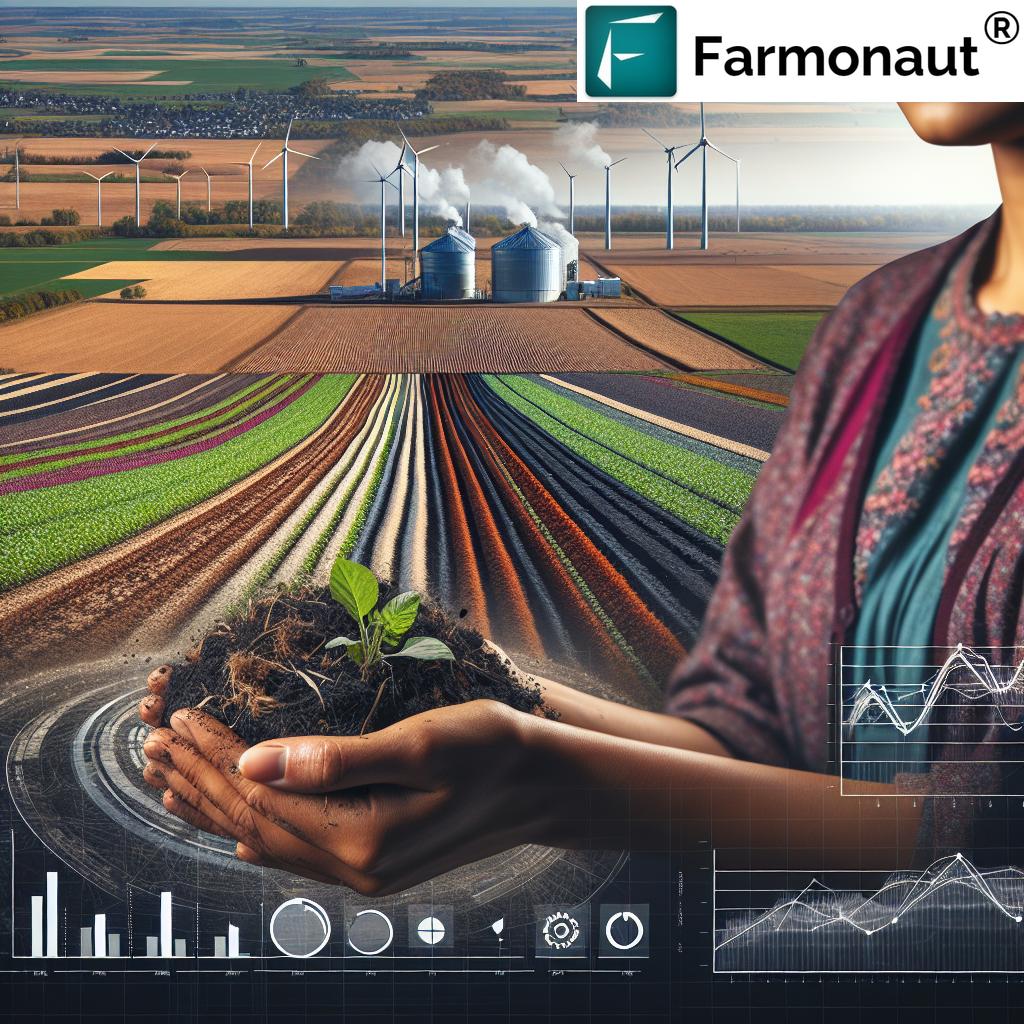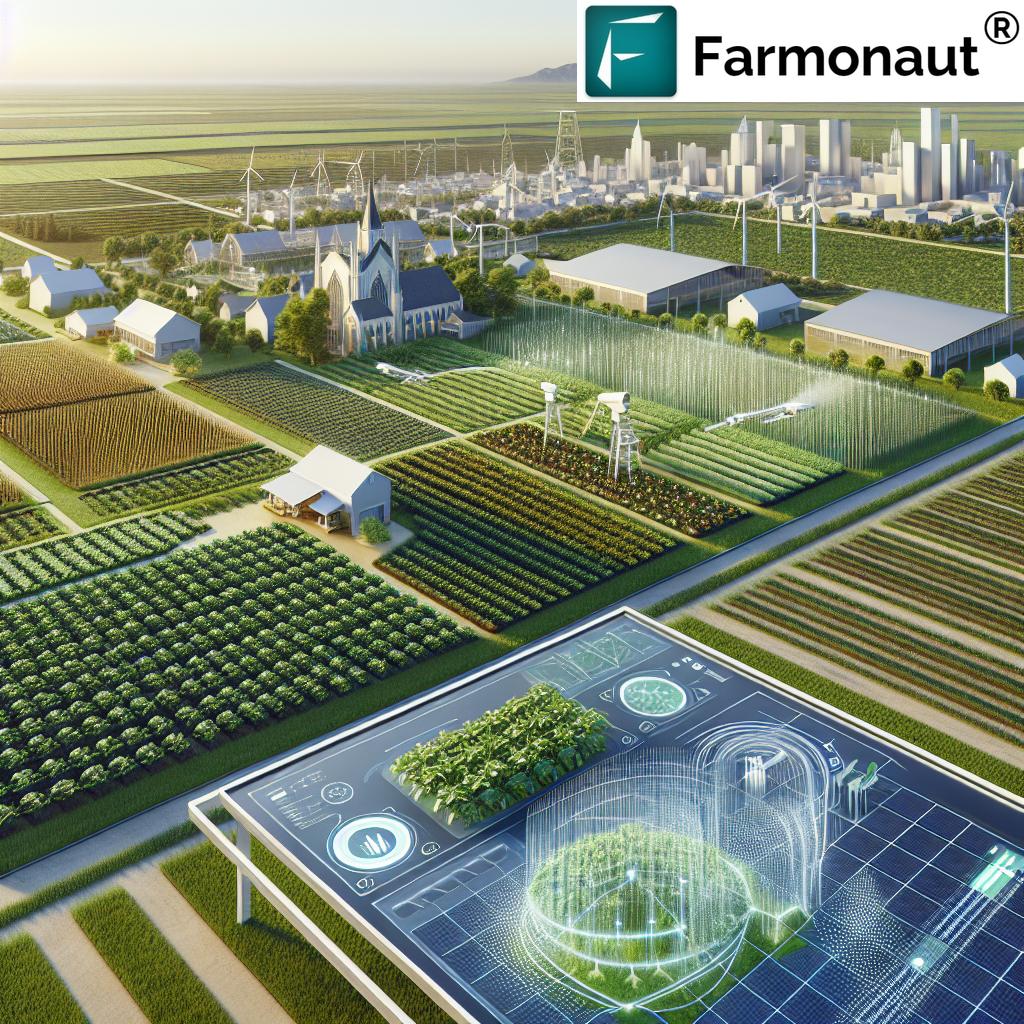Iowa’s Green Revolution: Cutting-Edge Techniques for Reducing Greenhouse Gas Emissions in Corn-Soybean Agriculture
“Early soybean planting techniques can reduce nitrous oxide emissions by up to 30% in corn-soybean rotations.”
Welcome to our comprehensive exploration of Iowa’s agricultural revolution, where cutting-edge techniques are paving the way for a greener future in corn-soybean agriculture. As we delve into the heart of the northern Corn Belt, we’ll uncover innovative strategies that are not only reducing greenhouse gas emissions but also optimizing crop yields and promoting sustainable farming practices.
The Urgency of Sustainable Crop Production
In the face of climate change, the agricultural sector finds itself at a critical juncture. With agriculture contributing significantly to global greenhouse gas emissions, the need for sustainable crop production has never been more pressing. Iowa, a cornerstone of American agriculture, is leading the charge in developing and implementing innovative techniques to reduce emissions while maintaining its status as a agricultural powerhouse.

Understanding Agricultural Emissions
Before we dive into the solutions, it’s crucial to understand the nature of agricultural emissions. Unlike industrial sectors that primarily emit carbon dioxide, agriculture’s emissions are predominantly nitrogen-based. In the United States, agriculture accounts for approximately 10% of total emissions, evenly split between methane from livestock and nitrous oxide from crop production.
In Iowa, the agricultural sector’s impact is even more pronounced, contributing to 30% of the state’s emissions. This proportion has grown as Iowa has made significant strides in adopting wind energy, highlighting the increasing importance of addressing agricultural emissions in the state’s overall climate strategy.
Groundbreaking Research in Emission Reduction
At the forefront of this green revolution is Michael Castellano, an agronomy professor at Iowa State University. Castellano and his team have embarked on a groundbreaking research initiative to explore and mitigate emissions from soybean production—an area that has been largely unexplored in the context of greenhouse gas emissions.
The team’s approach involves a comprehensive meta-analysis of nitrous oxide emissions in the northern Corn Belt. Their goal? To quantify emissions from continuous corn, soybean production, and corn-soybean rotations, and subsequently identify effective practices to reduce these emissions.
Innovative Techniques for Emission Reduction
Through their research, Castellano’s team has identified several key interventions that can significantly reduce greenhouse gas emissions in corn-soybean agriculture:
- Early Soybean Planting: This technique helps capture nitrogen before it escapes into the atmosphere, reducing nitrous oxide emissions.
- Cover Crops: Planting cover crops in the fall serves as another effective method to engage nitrogen and prevent its loss.
- Precision Nitrogen Management: Optimizing fertilizer levels in the corn-soybean rotation can minimize excess nitrogen that leads to emissions.
These interventions not only benefit the environment but also enhance agricultural productivity, demonstrating that addressing greenhouse gas emissions within the agricultural sector is both feasible and critical in the larger context of climate action.
Real-World Implementation and Results
To validate their theoretical findings, Castellano’s team has conducted real-time experiments across several states, including Iowa, Kentucky, Illinois, and Minnesota. The initial results are extremely promising:
- Implementing earlier soybean planting and cover crops reduced nitrous oxide emissions by approximately 15% in Iowa.
- These practices simultaneously boosted yields by around 10%, demonstrating that environmental benefits can go hand-in-hand with increased productivity.
These findings underscore the potential for widespread adoption of these techniques across the Corn Belt, offering a win-win solution for farmers and the environment.
The Role of Precision Agriculture in Emission Reduction
Precision agriculture plays a crucial role in implementing these emission reduction techniques effectively. Advanced technologies, such as those offered by Farmonaut, can provide farmers with real-time data on crop health, soil moisture, and weather patterns. This information enables farmers to make informed decisions about planting times, fertilizer application, and cover crop management.
By leveraging satellite-based farm management solutions, farmers can optimize their practices for both yield and environmental impact. Farmonaut’s platform offers valuable services such as real-time crop health monitoring and AI-based advisory systems, which can be instrumental in implementing the emission reduction techniques identified by Castellano’s research.
“Precision nitrogen management in agriculture can potentially decrease greenhouse gas emissions by 20-30% while maintaining crop yields.”
The Importance of Early Soybean Planting
One of the most significant findings from Castellano’s research is the impact of early soybean planting on reducing nitrous oxide emissions. This practice not only helps capture nitrogen before it escapes into the atmosphere but also has the potential to boost yields.
Castellano advocates for a shift in planting dates supported by the USDA. With the USDA’s influence in determining crop insurance planting dates, they could facilitate earlier planting while considering the risks posed by cold weather. Encouraging farmers to plant soybeans earlier could provide dual benefits—enhancing yield while simultaneously minimizing environmental nitrogen losses.

The Role of Cover Crops in Emission Reduction
Cover crops are another powerful tool in the fight against agricultural emissions. By planting cover crops in the fall, farmers can effectively engage nitrogen that would otherwise be lost to the environment. This practice not only reduces emissions but also improves soil health and reduces erosion.
Implementing cover crops requires careful planning and management. Tools like Farmonaut’s satellite-based monitoring can help farmers track the growth and health of their cover crops, ensuring maximum benefit from this practice.
Precision Nitrogen Management: A Key to Sustainable Agriculture
Precision nitrogen management is at the heart of reducing greenhouse gas emissions in corn-soybean rotations. By optimizing fertilizer levels, farmers can minimize excess nitrogen that leads to nitrous oxide emissions while maintaining or even improving crop yields.
This approach requires accurate data on soil conditions, crop health, and environmental factors. Farmonaut’s AI-driven personalized farm advisory tool, Jeevn AI, can provide real-time insights and expert crop management strategies to help farmers implement precision nitrogen management effectively.
The Future of Sustainable Corn-Soybean Agriculture
As climate change continues to accelerate, creating warmer spring conditions, the significance of these emission reduction techniques will only increase. The agricultural sector must adapt to these changing conditions while simultaneously working to mitigate its environmental impact.
The research conducted by Castellano and his team provides a roadmap for the future of sustainable corn-soybean agriculture. By implementing early soybean planting, cover crops, and precision nitrogen management, farmers can significantly reduce their greenhouse gas emissions while maintaining or even improving their yields.
Comparison of Greenhouse Gas Reduction Techniques in Corn-Soybean Agriculture
| Technique | Estimated Emission Reduction Potential | Impact on Crop Yield | Implementation Complexity |
|---|---|---|---|
| Early Soybean Planting | 15-30% | Positive | Medium |
| Cover Crops | 10-20% | Neutral to Positive | Medium |
| Precision Nitrogen Management | 20-30% | Neutral to Positive | High |
| Renewable Energy Integration | 5-15% | Neutral | High |
The Role of Technology in Implementing Sustainable Practices
Implementing these sustainable practices effectively requires the use of advanced agricultural technologies. Satellite-based farm management solutions, like those offered by Farmonaut, play a crucial role in this process. These technologies provide farmers with the data and insights they need to make informed decisions about planting times, fertilizer application, and crop management.
Farmonaut’s platform offers several key features that can support the implementation of emission reduction techniques:
- Satellite-Based Crop Health Monitoring: Real-time data on vegetation health and soil moisture can help farmers optimize their planting and management practices.
- AI-Driven Advisory System: Personalized recommendations can guide farmers in implementing precision nitrogen management and other sustainable practices.
- Carbon Footprinting: By tracking emissions in real-time, farmers can assess the effectiveness of their emission reduction strategies and make adjustments as needed.
For developers and businesses looking to integrate these advanced agricultural technologies into their own systems, Farmonaut offers API access. You can find more information about their API at https://sat.farmonaut.com/api, and access the developer documentation at https://farmonaut.com/farmonaut-satellite-weather-api-developer-docs/.
The Broader Impact of Sustainable Agriculture
The implications of these emission reduction techniques extend far beyond the borders of Iowa or even the Corn Belt. As the global population continues to grow and climate change intensifies, the need for sustainable agricultural practices becomes increasingly urgent.
By adopting these innovative techniques, farmers can:
- Reduce their environmental impact
- Improve soil health and fertility
- Increase resilience to climate change
- Potentially access new markets for sustainably produced crops
Moreover, these practices contribute to broader efforts to mitigate climate change, helping to create a more sustainable food system for future generations.
The Role of Policy in Promoting Sustainable Agriculture
While individual farmers can make significant strides in reducing emissions through these techniques, policy support is crucial for widespread adoption. Castellano’s advocacy for USDA support in shifting planting dates highlights the importance of policy in facilitating sustainable agricultural practices.
Other potential policy measures could include:
- Financial incentives for farmers who implement emission reduction techniques
- Support for research and development of new sustainable farming technologies
- Education and training programs to help farmers adopt new practices
- Integration of emission reduction goals into agricultural policy
By aligning agricultural policy with climate goals, we can create a supportive environment for the widespread adoption of these innovative, emission-reducing techniques.
Conclusion: A Green Revolution in Iowa and Beyond
The research conducted by Castellano and his team, along with the innovative technologies provided by companies like Farmonaut, are ushering in a new era of sustainable agriculture in Iowa and beyond. By implementing early soybean planting, cover crops, and precision nitrogen management, farmers can significantly reduce their greenhouse gas emissions while maintaining or even improving their yields.
This green revolution in corn-soybean agriculture demonstrates that environmental sustainability and agricultural productivity are not mutually exclusive. Instead, they can work hand in hand, creating a more resilient and sustainable food system for the future.
As we continue to face the challenges of climate change and food security, the innovations emerging from Iowa’s fields offer hope and a practical roadmap for sustainable agriculture worldwide. By embracing these cutting-edge techniques and technologies, we can work towards a future where agriculture is not just a contributor to climate change, but a key part of the solution.
FAQ Section
- Q: How significant are agricultural emissions in the overall greenhouse gas picture?
A: In the U.S., agriculture accounts for about 10% of total emissions, split evenly between methane from livestock and nitrous oxide from crop production. In Iowa specifically, agriculture contributes to 30% of emissions. - Q: What are the main techniques for reducing emissions in corn-soybean agriculture?
A: The main techniques include early soybean planting, use of cover crops, and precision nitrogen management. - Q: How effective is early soybean planting in reducing emissions?
A: Early soybean planting can reduce nitrous oxide emissions by up to 30% in corn-soybean rotations while also potentially increasing yields by around 10%. - Q: What role do cover crops play in emission reduction?
A: Cover crops help engage nitrogen effectively, preventing its loss to the atmosphere and reducing emissions. They also improve soil health and reduce erosion. - Q: How can precision agriculture help in implementing these emission reduction techniques?
A: Precision agriculture technologies, like those offered by Farmonaut, provide real-time data on crop health, soil moisture, and weather patterns. This information allows farmers to optimize their practices for both yield and environmental impact. - Q: Are these emission reduction techniques economically viable for farmers?
A: Yes, many of these techniques not only reduce emissions but also have the potential to increase yields or reduce input costs, making them economically beneficial for farmers. - Q: How can policy support the adoption of these sustainable practices?
A: Policy support can come in various forms, including financial incentives for farmers implementing emission reduction techniques, support for research and development, and integration of emission reduction goals into agricultural policy. - Q: What is the role of technology in sustainable agriculture?
A: Technologies like satellite-based crop monitoring, AI-driven advisory systems, and precision application tools play a crucial role in implementing and optimizing sustainable agricultural practices. - Q: How does climate change impact the effectiveness of these techniques?
A: As climate change leads to warmer spring conditions, the importance of techniques like early soybean planting is likely to increase. Climate change also underscores the urgency of adopting sustainable agricultural practices. - Q: Can these techniques be applied in other regions or for other crops?
A: While the research focused on the northern Corn Belt, many of these principles can be adapted for other regions and crops. However, specific strategies may need to be tailored to local conditions and crop types.




















